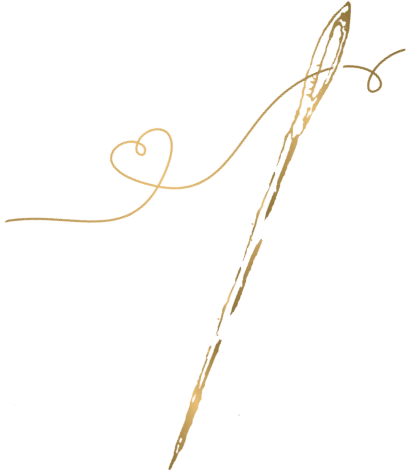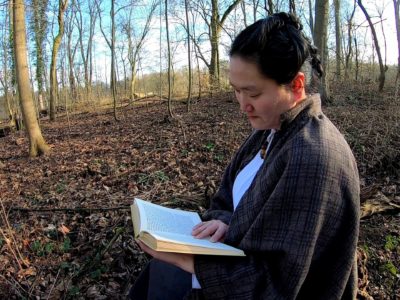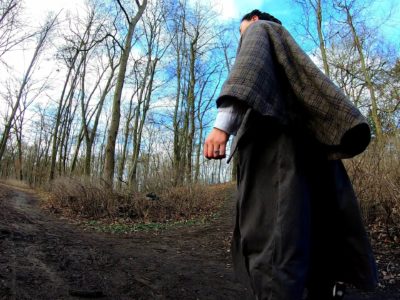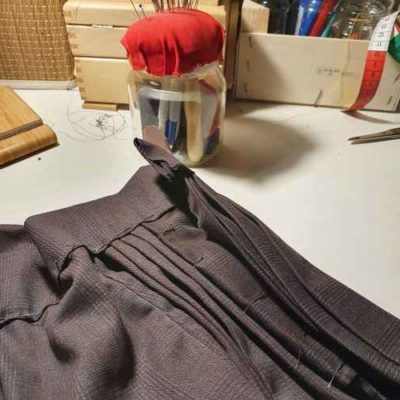FOUNDATIONS REVEALED COMPETITION ENTRY

Stine Rehbein in the Woods

Outline the story …
Curling up with a book – or an e-book – and getting lost in a story has long been as great a passion with me than any kind of needlework. I began crocheting as a child and, having lately discovered quite a few tailors in my family tree, the announcement of the 2021 Foundations Revealed competition seemed like a godsend to try my hands in sewing. As I have watched the videos of such great ladies as Bernadette Banner, Cathy Hay and others and derived incredible inspiration from them about the fashion and sewing of the late 19th century, I then took a deep breath and plunged myself headlong into drafting and making a walking skirt, petticoat and cape from late Victorian times. Theodor Fontane was one of Germany’s most famous writers from that era. He often wrote about strong-minded, determined females who are trying to find their ways and happiness in the tight corset of Prussian society. Although his most well-known literary heroine to this day is Effi Briest, I prefer the smaller novel “Stine” which I took as literary example for this little project. The story of “Stine Rehbein” unfolds in late 19th century Berlin, then the capital of Prussia. At first glance it appears to be a touching little story about love between different social classes, but there is so much more going on beneath the surface. Following the last chapter of Fontane's novel, I chose a late victorian walking skirt, cape and petticoat.
Outline the construction…
The first and most ambitious stage of my “Stine-Rehbein-sewing-journey” was certainly the drafting of the patterns. I took the instructions to these from the book “The Keystone Jacket and Dress Cutter” of 1895 and after I accepted the challenge thrown at me by the mathematics of measurements and the differences between the inch and cm-scaling, the drafting process of the cape and the walking skirt went on more smoothly than I had anticipated. I drafted the pattern on wrapping paper and old newspapers and made the mock-ups for the cape and the skirt. Luckily, I did quite a bit of shopping at the sales section of our local fabric shop in the days before that odious plague came upon us and collected some stash, For the mock-ups, I chose a light cotton and sewed the main straight seams with my trusty electric sewing machine. Naturally, I had to make some alterations, because I did not understand how the cape had to be draped until I tried the mock-up on. Afterwards, I procrastinated the last days of the old year away, trying to pluck up my courage for the 'real thing' and cutting the pieces for the skirt and cape out of some brown checked wool and cotton fabric from my aforementioned stash. Once I got the idea out of my head that sewing and dressmaking should have to do anything with speed, I could even enjoy the process of preparing all the pieces and even the all the hand-sewing.






Lovely!
I completely identify with your comment about getting it out of one’s head that sewing has anything to do with speed! I love your costume and enjoyed reading about your inspiration for it.
How exciting that you’re carrying on the family’s tailoring traditions, Miriam! I love your ensemble — I really like how the cape falls in particular. It looks like just the right balance of close enough to keep you warm, but swooshy enough to have dramatic flare like when you’re twirling in the photo!! I’m glad you were able to overcome the brain hamsters and get to the final steps of this project, as it’s really delightful and functional pieces that you should be proud of!
Thank you so much, Andrea, for your kind comment! The project was really great fun and finishing it encouraged me a great deal to pursue further in the footsteps of my great-grandfather. In fact, I am already wearing the walking skirt as part of my daily wardrobe, at work also.
That cape is lovely! Great job❤